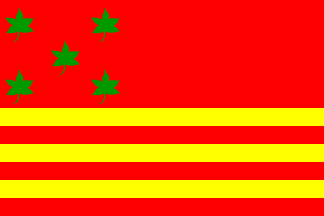 image by António Martins-Tuválkin, 19
November 2007
image by António Martins-Tuválkin, 19
November 2007
Last modified: 2012-01-13 by ian macdonald
Keywords: bahia | ilhéus | fig leaves: 5 |
Links: FOTW homepage |
search |
disclaimer and copyright |
write us |
mirrors
 image by António Martins-Tuválkin, 19
November 2007
image by António Martins-Tuválkin, 19
November 2007
Ilhéus is a municipality in southern coastal Bahia state (Sul Baiano
mesoregion, Ilhéus-Itabuna microregion), Brazil, with 220 932 inhabitants (est.
2006) in 1840.99 km2. The eponymous municipal city is well known for
being the setting of Jorge Amado’s novel Gabriela Cravo e Canela and was
once the world's leading cocoa export center. "Ilhéus" means "islets" (or
"islanders") See also
http://en.wikipedia.org/wiki/Ilh%C3%A9us (in English) and
http://pt.wikipedia.org/wiki/Ilh%C3%A9us (in Portuguese).
The flag
can be seen at
http://www.ilheense.com.br/bandeira.htm and at
http://pt.wikipedia.org/wiki/S%C3%ADmbolos_de_Ilh%C3%A9us#Bandeira . It is a
2:3 red flag with three horizontal yellow stripes covering the bottom half
(intervals as wide as each stripe) and five green fig leaves set in saltire on
the upper hoist. This flag design was based on the city coat of arms, itself
based on the arms of Jorge de Figueiredo Correia, the Portuguese nobleman who
received the first captainship of the area in 1534. These were per pale Gules
five fig leaves Vert and Gules fretty Or (marshaled family arms of Figueiredo
and Correia); the city coat of arms keeps this blazon with additional crest and
supporters.
The flag was designed by local teacher Leopoldo Campos
Monteiro and approved by law nº872 of 1965.05.07, which also adopted red and
green as the official colors of the municipality. The detailed description given
by the law calls for the leaves to have a "golden shadow" (fimbriation?), surely
due to heraldic concerns: The
image at local
unofficial website "Ilheense" lacks this shadowing while the
Portuguese
Wikipedia image includes it.
António Martins-Tuválkin, 19 November
2007